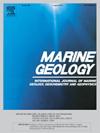Late Quaternary high-resolution shallow seismic interpretation: Recognition of depositional sequences and systems tracts in response to sea-level changes in the northernmost part of the central Vietnam continental shelf
IF 2.2
3区 地球科学
Q2 GEOSCIENCES, MULTIDISCIPLINARY
引用次数: 0
Abstract
This study presents the findings from a high-resolution shallow seismic profiles acquired in the northernmost part of the central Vietnam continental shelf. The purpose was to investigate the evolution of the late Quaternary succession. The seismic grid was correlated with two geotechnical boreholes and five gravity cores, providing a comprehensive understanding of the late Quaternary stratigraphy. The seismic stratigraphic interpretation reveals four major seismic facies (F1–F4) and identifies six stratigraphic unconformity surfaces, establishing their relationship with six seismo-stratigraphic sequences and the corresponding depositional system tracts within each sequence. The sequence boundaries have been erosively truncated by a series of incised channels/valleys. These boundaries were unconformably overlain by seismic facies F1 and F2. These facies comprise mostly high amplitude and discontinuous to continuous reflections. They were deposited during a period of relative sea-level fall, resulting in fluvial lowstand deposits of the lowstand systems tract (LST). Below this boundary, toplap terminations of clinoform were observed, corresponding to facies F3. This facies comprise primarily a progradational stacking pattern of the highstand systems tract (HST), transitioning downlap into thinner deposit toward the east-southeast. This suggests the eastward and southeastward transport of sediments from the edge of the Vietnamese mainland, as confirmed by the orientation of the incised channels/valleys. The transgressive systems tract (TST) is thin, and correlates with the seismic characteristics of facies F4, with low amplitude to transparent reflections. This systems tract is commonly bounded above by the highstand systems tract (HST) and below by the lowstand systems tract (LST).
晚第四纪高分辨率浅层地震解释:越南中部大陆架最北端海平面变化响应的沉积序列和体系域识别
本研究介绍了在越南中部大陆架最北端获得的高分辨率浅层地震剖面的发现。目的是探讨晚第四纪演替的演变。地震格网与2个岩土钻孔和5个重力岩心进行了对比,全面了解了晚第四纪地层。地震地层解释揭示了4个主要地震相(F1-F4),识别了6个地层不整合面,建立了它们与6个地震地层层序的关系,并在每个层序内建立了相应的沉积体系域。层序边界已被一系列切割的河道/山谷侵蚀截断。这些边界被F1和F2地震相不整合覆盖。这些相主要包括高振幅和不连续到连续的反射。它们是在相对海平面下降时期沉积的,形成了低水位体系域(LST)的河流低地沉积。在此界线下方,可见斜仿岩顶顶终止,对应于F3相。该相主要由高水位体系域(HST)的进积叠加模式组成,向东-东南方向由下覆过渡为较薄的沉积。这表明沉积物从越南大陆边缘向东和东南方向移动,正如切割的河道/山谷的方向所证实的那样。海侵体系域(TST)较薄,与F4相地震特征相关,反射幅值低至透明。这个系统域通常由高水位系统域(HST)和低水位系统域(LST)组成。
本文章由计算机程序翻译,如有差异,请以英文原文为准。
求助全文
约1分钟内获得全文
求助全文
来源期刊

Marine Geology
地学-地球科学综合
CiteScore
6.10
自引率
6.90%
发文量
175
审稿时长
21.9 weeks
期刊介绍:
Marine Geology is the premier international journal on marine geological processes in the broadest sense. We seek papers that are comprehensive, interdisciplinary and synthetic that will be lasting contributions to the field. Although most papers are based on regional studies, they must demonstrate new findings of international significance. We accept papers on subjects as diverse as seafloor hydrothermal systems, beach dynamics, early diagenesis, microbiological studies in sediments, palaeoclimate studies and geophysical studies of the seabed. We encourage papers that address emerging new fields, for example the influence of anthropogenic processes on coastal/marine geology and coastal/marine geoarchaeology. We insist that the papers are concerned with the marine realm and that they deal with geology: with rocks, sediments, and physical and chemical processes affecting them. Papers should address scientific hypotheses: highly descriptive data compilations or papers that deal only with marine management and risk assessment should be submitted to other journals. Papers on laboratory or modelling studies must demonstrate direct relevance to marine processes or deposits. The primary criteria for acceptance of papers is that the science is of high quality, novel, significant, and of broad international interest.
 求助内容:
求助内容: 应助结果提醒方式:
应助结果提醒方式:


